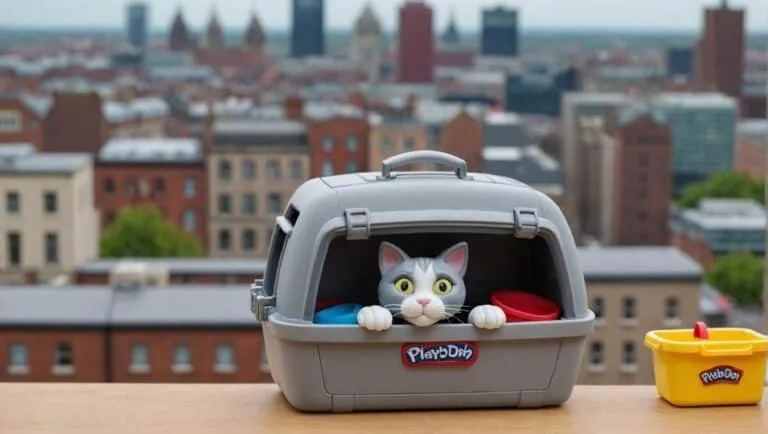The Best Fluffy Pancakes recipe you will fall in love with. Full of tips and tricks to help you make the best pancakes.

Rehoming your cat in Aberdeen can be a tough but compassionate decision. You might face health issues, allergies, or changes in lifestyle that make it hard to care for your furry friend. Start by considering alternatives, like addressing behavioral problems or seeking help from local shelters. If rehoming is necessary, be transparent about your cat’s needs and gather significant documents. This guarantees your cat finds a loving home. Remember, it’s normal to feel guilt during this process. Support is available, and you’ll discover effective strategies to ease the shift and contribute to your cat’s well-being as you progress.
Why Cats Get Rehomed in Aberdeen

Rehoming your cat can be a tough decision, often prompted by unexpected health issues in your family or misunderstandings about what caring for a cat truly entails.
In Aberdeen, local shelters are feeling the impact, as intake numbers rise and more cats find themselves in need of new homes.
Understanding these reasons can help you make informed choices that not only benefit your family but also give a deserving cat a second chance.
Health Issues in Family Members
When health issues arise in family members, many pet owners may find themselves faced with the difficult decision to find a new home for their beloved cats. Allergies, in particular, can be a significant concern, impacting family health and quality of life. If someone in your household develops a cat allergy, it can lead to uncomfortable symptoms and stress for everyone involved.
Managing these allergies may require drastic measures, including rehoming your feline friend. It’s essential to weigh your options carefully, considering not just your cat’s needs but also the well-being of your family. Before making a decision, explore all possible solutions, such as enhancing allergy management through regular cleaning, air purifiers, or specific medications.
You’re not alone in this situation; many families face similar challenges. Remember, rehoming your cat doesn’t mean you love them any less. It’s about ensuring both your family’s health and your pet’s happiness.
If you do decide to find a new home, consider reaching out to local shelters or trusted friends. They can help you find a loving environment where your cat will thrive.
Local Shelter Intake Numbers
Understanding the reasons behind rehomed cats can help you make a more informed decision about finding a new home for your pet.
In Aberdeen, there are multiple cat shelters and rescues that provide assistance in rehoming cats and kittens. For example, the Cat Action Trust North East Scotland rescues stray, abandoned, domestic, and feral cats, ensuring they receive proper care before being placed in safe and loving homes.
Similarly, the Cats Protection Aberdeen Branch, with areas covered in Aberdeen city and surrounding regions, supports cat rehoming along with educational initiatives and awareness programs.
Insights from local shelters can help you navigate the rehoming process effectively.
Analyzing shelter capacity and intake trends can highlight the most pressing needs and challenges faced by these organizations.
Misconceptions about cat ownership and care requirements
Many people underestimate the level of commitment and care that cats require, leading to unintentional situations where these beloved pets are rehomed in Aberdeen.
There are numerous cat myths and owner stereotypes that contribute to this misunderstanding. For instance, some believe that cats are low-maintenance and can thrive on their own, which simply isn’t true. While cats are more independent than dogs, they still need regular interaction, mental stimulation, and proper veterinary care.
Another common misconception is that all cats are aloof and unfriendly. In reality, many cats are affectionate and thrive on companionship.
It’s important to understand that each cat has its own personality and needs, and neglecting those can lead to behavioral issues.
Alternatives to Rehoming
If you’re facing challenges with your cat, like litter box issues or adjusting to a new baby, rehoming doesn’t have to be your only option.
There are effective strategies and resources available, such as low-cost spay and neuter clinics, that can help you keep your furry friend.
Exploring these alternatives can lead to a happier home for both you and your cat.
Managing Litter Box Problems
If your cat’s having litter box issues, it can be frustrating, but there are effective solutions before considering rehoming.
Consulting a feline expert, providing interactive toys, and ensuring a veterinary exam can uncover the root of the problem and help restore harmony in your home.
Let’s explore these alternatives together to improve your cat’s behavior and enhance your bond.
Consulting a Feline Expert
Consulting a feline expert can often provide you with valuable insights and solutions for managing your cat’s litter box issues before considering rehoming.
Understanding feline behavior is essential, and expert advice can help identify the root causes of the problem.
Interactive Toys and Puzzles
Engaging your cat with interactive toys and puzzles can significantly reduce litter box issues by keeping them mentally stimulated and focused, ultimately enhancing their overall well-being.
These activities encourage interactive play and provide cognitive stimulation, helping to channel excess energy into something positive.
Veterinary Exams for Underlying Issues
Understanding the root causes of your cat’s litter box issues often starts with a veterinary exam, which can reveal underlying health problems that need attention.
Reviewing your cat’s veterinary records and scheduling regular health screenings can help you identify issues early.
Low-Cost Spay/Neuter Clinics
If you’re considering rehoming your cat due to an overwhelming number of kittens, low-cost spay/neuter clinics can provide a viable solution that helps control the pet population while keeping your furry friend at home. These affordable clinics are often available through community resources, making it easier for you to access the care your cat needs without breaking the bank.
By opting for spaying or neutering, you’re not only preventing future litters but also enhancing your cat’s overall health and behavior. Many clinics offer services at reduced rates, and some even provide assistance for families in need. It’s a compassionate choice that reflects your commitment to responsible pet ownership.
Take the time to research local options; you might be surprised by the support available in your community. Many organizations even run outreach programs to educate pet owners about the benefits of spaying and neutering.
Welcoming a Newborn Baby
Welcoming a newborn baby into your home can be a joyous yet challenging time, especially when you have a cat to take into account. However, there are practical ways to help both your new arrival and your feline friend coexist happily.
Start with baby introductions; allow your cat to observe the baby from a distance, letting them get used to the new sounds and smells. This gradual approach helps reduce anxiety for both your cat and the baby.
Creating safe spaces is essential. Designate areas in your home where your cat can retreat if they feel overwhelmed. This gives them a sense of security while allowing the baby to explore their new environment. You might also consider using baby gates to keep them separated during the initial phases.
Always supervise interactions, and never force your cat to engage with the baby. Instead, encourage gentle behavior and reward your cat with treats when they remain calm.
Unmanageable Behavioral Issues

If you’re facing unmanageable behavioral issues with your cat, it’s important to contemplate the impact on both your well-being and your pet’s quality of life.
Severe allergies, unsafe living conditions, or the inability to provide long-term care can create a difficult situation for both of you.
Recognizing these challenges is the first step towards finding a compassionate solution that prioritizes your cat’s needs.
Severe allergies that can’t be managed
Severe allergies can create an overwhelming challenge for cat owners, making it essential to contemplate rehoming if symptoms persist despite all efforts to manage them. If you’ve tried various allergy management strategies, including dietary changes and cat supplements, yet you’re still struggling, you’re not alone. Allergies can profoundly impact your quality of life, affecting your health and your ability to care for your feline companion.
Rehoming isn’t a failure; it’s a compassionate decision that prioritizes both your well-being and your cat’s happiness. Consider how much better your cat could thrive in a home where allergies aren’t an issue.
Before taking this step, you might want to consult with a veterinarian to explore all possible options. Sometimes, specific allergy management techniques can make a difference, but if these have proven unmanageable, it may be time to look for a loving home where your cat can flourish.
Unsafe living situations for the cat
Unmanageable behavioral issues can create an unsafe environment for your cat, making it essential to assess rehoming for their safety and well-being. Cats displaying aggression, excessive anxiety, or destructive behaviors often thrive in calmer, more stable settings. If your home has become a harmful environment due to these issues, it’s vital to reflect on how you can best serve your cat’s needs.
Implementing cat safety measures—like providing a designated quiet space or engaging in regular playtime—can sometimes alleviate behavioral problems. However, if these strategies aren’t effective, the stress can lead to further complications for both you and your cat. A rehoming decision isn’t about failure; it’s about recognizing what’s best for your furry friend.
Think about reaching out to local shelters or rescue organizations that prioritize cat welfare. They can help match your cat with a loving home that can better accommodate their needs, ensuring they’re in a nurturing environment. By taking this step, you’re not only prioritizing your cat’s safety but also allowing them the opportunity for a happier, healthier life. Your willingness to evaluate the situation speaks to your compassion and commitment to their well-being.
Inability to provide proper care long-term
When behavioral issues become overwhelming, your ability to provide the long-term care your cat needs may be compromised, making it important to contemplate rehoming for their sake. Unmanageable behavioral problems can lead to stress not only for your cat but for you as well. If you’re struggling with these challenges, it’s essential to recognize that your well-being and financial stability are just as important.
Cats require long-term commitments, and if your circumstances change—be it due to work, family, or health issues—your capacity to address their needs might diminish. This could result in a cycle of frustration, leading to inadequate care for your furry friend. Remember, rehoming doesn’t signify failure; it’s an act of love when you prioritize their happiness and well-being.
Consider reaching out to local shelters or rescue organizations. They can guide you in finding a suitable new home, ensuring your cat’s behavioral needs are met. By taking this step, you’re not just alleviating your burden; you’re giving your cat the chance to thrive in an environment that can offer them the stability and care they deserve.
How to Rehome a Cat Responsibly in Aberdeen
When you’re rehoming your cat in Aberdeen, it’s vital to guarantee their future is bright and safe.
You can find a suitable new home directly or partner with reputable rescue organizations that prioritize animal welfare.
Finding a suitable new home directly
To guarantee your cat finds a loving and suitable new home in Aberdeen, it’s important to approach the rehoming process with care and responsibility. Start by reaching out to your community. Share your situation through social media, local groups, and community outreach programs. The more people know, the higher the chances of finding the right match.
When potential adopters express interest, conduct personalized interviews to get to know them better. Ask about their experience with pets, their living situation, and how they plan to integrate your cat into their home. This not only helps you gauge their suitability but also assures they understand the commitment involved in pet ownership.
Be transparent about your cat’s personality, needs, and any quirks they may have. Providing detailed information fosters trust and allows potential adopters to make informed decisions. Additionally, consider asking for references from previous pet owners, as this can provide further insight into the adopter’s suitability.
Working with reputable rescue organizations in Aberdeen
Now that you have prepared your cat’s profile and conducted thorough interviews with potential adopters, you might want to contemplate reaching out to reputable rescue organizations in Aberdeen for additional assistance.
Local organizations like the Aberdeen Area Humane Society, which received a grant from American Humane’s Feed the Hungry fund to care for homeless animals during the pandemic, are essential for the local community.
These organizations offer a higher level of community support and have stronger networks for rehoming pets. Working with these groups can expand your reach to a broader audience, maximizing the chances of finding the best possible home for your cat.
Gather Essential Grooming Supplies
Gathering essential grooming supplies not only guarantees your cat looks their best for potential adopters, but it also helps them feel more comfortable during the shift to a new home.
Start by collecting quality brushes suited for your cat’s coat type—whether it’s long or short. Regular brushing is one of the key grooming techniques that can reduce shedding and matting while also giving your cat a soothing experience.
Next, don’t forget nail clippers, as keeping your cat’s nails trimmed is crucial for their health and safety. Look for cat-friendly clippers that make the process easier for you and less stressful for them. A soft, damp cloth can also be handy for cleaning their eyes and ears gently.
Lastly, consider investing in a good cat shampoo, especially if your feline friend needs a bath. Essential grooming isn’t just about appearance; it’s about their well-being too.
Screening potential adopters
Screening potential adopters is essential for ensuring your cat finds a loving and suitable forever home. Start by reaching out through social media outreach to connect with interested individuals; it’s a great way to gauge their interest and commitment. Make sure to ask specific questions about their experience with cats, their living situation, and how they plan to care for your feline friend.
Once you’ve narrowed down your list, arrange a home visit. This step is vital; it allows you to see the environment your cat would be living in and assess whether it’s a safe and welcoming space. During the visit, observe how the potential adopter interacts with your cat. Their demeanor and approach will give you valuable insight into their suitability.
Don’t hesitate to trust your instincts. If something feels off, it’s okay to continue your search for the right match. Remember, your cat deserves a loving home where they’ll be cherished.
The Rehoming Process

When you’re ready to rehome your cat, it’s crucial to start with some important initial steps to guarantee a smooth changeover.
You’ll need to gather the required documentation to make the process easier for you and the new owner.
Initial steps to take
Before you consider rehoming your cat, it’s vital to evaluate your circumstances and understand the commitment involved in finding them a loving new home.
Take a moment to reflect on why you’re rehoming your cat—whether it’s due to lifestyle changes, allergies, or other challenges. Recognizing your motivations can help you approach this process with compassion.
Start by reaching out to local community resources dedicated to cat adoption. These organizations often offer guidance, support, and connections to potential adopters who genuinely care about animal welfare. They can help you create a profile for your cat, highlighting their personality and needs, which will attract the right families.
Additionally, consider spreading the word among friends, family, and colleagues. Personal networks can often lead to finding a suitable home for your feline friend. Share your cat’s story and the love they deserve, as this can resonate with others who might be looking to adopt.
Ultimately, your goal is to guarantee your cat’s well-being and happiness. By taking these initial steps, you’ll set the stage for a successful change into a new loving home.
Required documentation
As you prepare to find a new home for your cat, gathering the necessary documentation will help guarantee a smooth rehoming process and reassure potential adopters of your commitment to your feline’s well-being.
Start by compiling the required health records, which should include vaccination history, any recent veterinary check-ups, and treatment for any medical conditions. This documentation not only provides transparency but also builds trust with prospective adopters.
Next, verify you meet the identification requirements for rehoming. This may involve providing a microchip registration, if applicable, or a detailed description of your cat’s personality and habits. By sharing this crucial information, you’re helping potential owners understand what they can expect, making their decision to adopt much easier.
Transition period for the cat
The change period for your cat can be a sensitive time, so it’s essential to create a calm and welcoming environment to help them adjust to their new home. Start by setting up a quiet space where your cat can feel safe—this could be a small room with their bed, litter box, and toys. Environment adjustments like minimizing noise and movement will greatly ease their anxiety.
Implement adjustment strategies that allow your cat to explore their new surroundings at their own pace. Gradually introduce them to different areas of your home, ensuring they feel comfortable before moving on. Use soft, soothing voices to reassure them, and spend time near them without overwhelming them with attention.
Familiar smells can also be comforting, so consider using a blanket or toy from their previous home. Keep their routine consistent, from feeding times to play schedules, to build a sense of normalcy.
Coping with Guilt and Emotional Aspects
It’s completely normal to feel guilt when rehoming your cat, but recognizing the health risks they might face in your current situation can help ease that burden.
Ensuring a stress-free change for both you and your cat is essential, and you’re not alone in this process—joining local pet owner groups can provide valuable support and resources.
Let’s explore these aspects together to help you make the best decision for your furry friend.
Recognizing Health Risks for Cats
Recognizing the potential health risks your cat may face after rehoming can help ease the guilt and emotional turmoil you might feel during this difficult change. It’s important to be proactive about their well-being.
After rehoming, make sure that the new owner schedules cat health screenings. These screenings can detect underlying health issues early, giving your cat the best chance for a long, healthy life.
Feline nutrition is another critical factor to contemplate. Shifting to a new environment can affect a cat’s appetite and digestion. Encourage the new owner to consult a veterinarian about a balanced diet tailored to your cat’s specific needs.
Quality food plays a significant role in maintaining their health, especially during times of stress.
Ensuring a Stress-Free Transition
Steering through the emotional landscape of rehoming your cat can be challenging, but understanding how to guarantee a stress-free alteration for both you and your feline friend can make a world of difference.
First, acknowledge your feelings of guilt and sadness; it’s completely normal. Remember, you’re making a choice that’s best for your cat’s future.
To facilitate a smooth shift, consider implementing positive reinforcement. This means rewarding your cat for calm behavior during the move, helping them associate the change with positive experiences. Use treats, affection, or their favorite toys to create a comforting environment in their new home.
Additionally, focus on stress reduction techniques, like keeping their routine as consistent as possible. Provide familiar items, such as their bed or blanket, to make them feel secure.
Communicate with the new owner about your cat’s habits to guarantee they continue that familiarity.
Joining Local Pet Owner Groups
Joining local pet owner groups can provide invaluable support as you navigate the guilt and emotional challenges of rehoming your cat. These communities often understand the heart-wrenching decisions you’re facing and can offer a listening ear or a shoulder to cry on. When you connect with others who’ve experienced similar situations, you’ll feel less isolated and more empowered.
Many local groups focus on pet adoption and responsible rehoming, sharing resources that can help you find the perfect new home for your cat. They can guide you through the process, ensuring your feline friend adapts smoothly while maintaining your peace of mind. Community support is essential during such a tough time; it reminds you that you’re not alone.
Engaging with these groups also allows you to share your experiences and learn from others. You’ll find comfort in knowing that many have faced the same guilt and emotional turmoil, and together, you can create a network of understanding.
Understanding Breed-Specific Needs

When you’re considering rehoming a cat, understanding their breed-specific needs is essential for a smooth changeover.
Different breeds have unique temperaments, training requirements, and ongoing financial responsibilities that can affect your decision.
Understanding Breed Temperament Differences
Understanding the unique temperament of different cat breeds is essential for ensuring you meet their specific needs and create a harmonious home environment.
When you consider a breed comparison, you’ll notice distinct personality traits that can greatly influence your experience as a cat owner. For instance, Siamese cats are often vocal and social, thriving in interactive settings, while Persian cats tend to be more laid-back and enjoy quiet spaces.
It’s vital to match your lifestyle with the temperament of the breed you choose. If you’re active and enjoy playtime, a spirited Abyssinian or Bengal might be a perfect fit. On the other hand, if you prefer a serene environment, a Ragdoll or British Shorthair could suit you better.
Time Investment for Training
Investing time in training your cat is essential, especially since different breeds have unique needs and learning styles that can affect how quickly they adapt to their new home. Understanding your cat’s breed-specific traits can help you tailor your training techniques and make the most of your time commitment.
For example, some breeds, like Siamese, thrive on mental stimulation and may require interactive toys or puzzles, while others, like Persians, might prefer a more relaxed approach.
Start by establishing a daily routine, which helps your cat feel secure and understand what to expect. Use positive reinforcement to encourage good behavior, as this technique works wonders across various breeds. Be patient and consistent; training isn’t an overnight process.
Consider setting aside dedicated time each day for training sessions, even if it’s just 10-15 minutes. This investment not only strengthens your bond but also sets a solid foundation for a happy and well-adjusted cat.
Ongoing Financial Responsibilities
As you build a strong bond with your cat through training, it’s equally important to take into account the ongoing financial responsibilities that come with meeting their breed-specific needs.
Each breed has unique characteristics that may require specific dietary, grooming, or medical care, impacting your budget considerably. For instance, a Persian cat may need regular grooming to prevent matting, while a Siamese may require more interactive toys to stimulate their energetic nature. Understanding these needs helps you anticipate costs and avoid surprises.
To manage these expenses effectively, consider implementing some budgeting tips. Start by tracking your monthly expenses related to your cat, from food and litter to vet visits. This will give you a clearer picture of your financial commitment.
Additionally, explore options for financial aid, such as local charities or community programs that offer assistance with pet care costs.
Final Thoughts
Rehoming a cat can be a tough decision, but it’s sometimes necessary for their well-being.
By understanding the reasons behind rehoming and exploring alternatives, you can make the best choice for both you and your feline friend.
Remember, taking the time to find a responsible new home guarantees a brighter future for your cat.
You’re not alone in this process; many resources are available in Aberdeen to help you navigate your journey with compassion and care.








